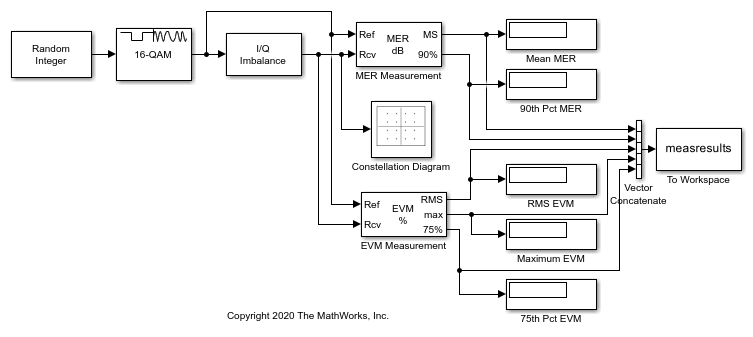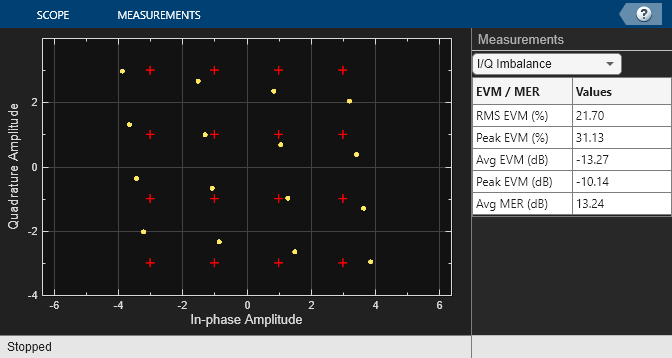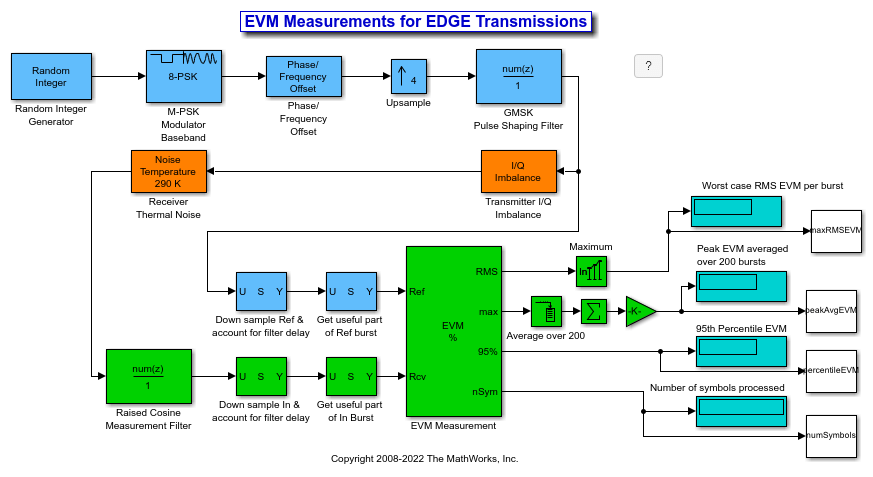Measure Modulation Accuracy
Error vector magnitude (EVM) and modulation error ratio (MER) measure the accuracy of modulator and demodulator performance in the presence of signal transmission impairments. For more information on impairments, see Visualize RF Impairments.
EVM is the vector difference at a given time between the ideal (transmitted) signal and the measured (received) signal. These measurements help to identify sources of signal degradation, such as phase noise, IQ imbalance, amplitude nonlinearity, and filter distortion. Standards specify EVM performance requirements. For example, 3GPP radio transmission standards [1] specify RMS EVM, peak EVM, and 95th percentile for the EVM performance requirements.
MER is a form of signal-to-noise ratio (SNR) measurement for assessing the ability of a receiver to accurately demodulate a signal. MER measures symbol errors introduced by Gaussian noise and other uncorrectable impairments of the received constellation. If the only significant impairment in the signal is Gaussian noise, then MER and SNR are equivalent. For example, the DVB measurement guidelines [4] specify minimum MER and percentile MER performance requirements.
To measure modulation accuracy, you can use these Communications Toolbox™ System objects and blocks. The examples that follow show you how.
| System object™ | Block |
|---|---|
comm.EVM | EVM Measurement |
comm.MER | MER Measurement |
Modulation Accuracy Examples
Measure EVM and MER Using Simulink
This example shows how to compute error vector magnitude (EVM) and modulation error rate (MER) measurements using Simulink® blocks.
The doc_mer_and_evm model adds IQ imbalance to a 16-QAM signal. The EVM Measurement and MER Measurement blocks perform EVM and MER measurements, respectively, on the impaired signal. The Constellation Diagram block displays the impaired signal constellation and signal quality measurements. The signal quality measurements displayed in the constellation diagram window approximate the measurements reported by the EVM Measurement and MER Measurement blocks.

In this model, the I/Q Imbalance block sets the amplitude imbalance to 1 dB, the phase imbalance to 15 degrees, and the DC offset to 0. The MER Measurement block is configured to output the mean MER and the 90th percentile MER. The EVM Measurement block is configured to output the RMS EVM (normalized to the average reference signal power), the maximum EVM, and the 75th percentile EVM.
Run the model to compute the EVM and MER measurements and to display the constellation diagram.
Average MER is 13.2 dB. 90 percentile MER is 10.3 dB. RMS EVM is 21.8%. Maximum EVM is 31.5%. 75 percentile EVM is 26.8%.

Change the I/Q Imbalance block setting for the amplitude imbalance to 2 dB. Because the modulation accuracy decreases when the impairment value increases, the reported average MER decreases and the reported average EVM increases. Run the model again to see the degraded EVM and MER metrics.

Average MER is 13.2 dB. 90 percentile MER is 10.2 dB. RMS EVM is 21.8%. Maximum EVM is 31.2%. 75 percentile EVM is 26.8%.
Measure EVM for EDGE Transmissions in Simulink
This example shows how to measure modulation error impairments for an EDGE transmitter design by using EVM measurements. The EVM Measurement block compares an ideal reference signal to a measured signal, and then computes RMS EVM, maximum EVM, and percentile EVM values.
The doc_evm model includes an EDGE transmitter, impairments, and EVM calculations.

Transmitter --- The
doc_evm_init.mhelper file initializes a parameter structure that the model uses to generate the EDGE transmission bursts. The Random Integer Generator block simulates random data generation. The EDGE standard specifies that the transmitter performs measurements during the useful part of the burst (excluding tail bits) over at least 200 bursts. In this mode, the transmitter produces 435 symbols per burst (9 additional symbols account for filter delays). The Phase/Frequency Offset block provides continuous phase rotation to the signal. For synchronization purposes, the Upsample block oversamples the signal by a factor of 4. The Discrete FIR Filter (Simulink) block provides GMSK pulse linearization, which is the main component in a Laurent decomposition of the GMSK modulation [3]. A helper function computes the filter coefficients and uses a direct-form FIR digital filter to create the pulse shaping effect. The filter normalization provides unity gain at the main tap. The I/Q Imbalance Compensator block simulates transmitter impairments. This block adds rotation to the signal, simulating a defect in the transmitter under test.
phase rotation to the signal. For synchronization purposes, the Upsample block oversamples the signal by a factor of 4. The Discrete FIR Filter (Simulink) block provides GMSK pulse linearization, which is the main component in a Laurent decomposition of the GMSK modulation [3]. A helper function computes the filter coefficients and uses a direct-form FIR digital filter to create the pulse shaping effect. The filter normalization provides unity gain at the main tap. The I/Q Imbalance Compensator block simulates transmitter impairments. This block adds rotation to the signal, simulating a defect in the transmitter under test.
Amplitude imbalance = 0.25 dB
Phase imbalance = 0.75 degrees
Receiver --- The Receiver Thermal Noise block represents receiver impairments. This model assumes 290 K of thermal noise, representing imperfections of the hardware under test.
EVM calculation --- The EVM measurement block computes the vector difference between an ideal reference signal and an impaired signal. The output of the FIR filter provides the Reference input for the EVM block. The output of the Noise Temperature block provides the impaired signal at the Input port of the EVM block. While the block has different normalization options available, the EDGE standard requires normalizing by the Average reference signal power. For illustration purposes in this example, the EVM block outputs RMS, maximum, and percentile measurement values.
EDGE standard EVM specifications --- According to the EDGE standard [1], the error vector magnitude of the received signal, calculated relative to the transmitted waveform, must not exceed these values:
T =
3×4 table
MS Normal MS Extreme BS Normal BS Extreme
_________ __________ _________ __________
RMS EVM 9% 10% 7% 8%
Peak EVM 30% 30% 22% 22%
95th Percentile EVM 15% 15% 11% 11%
Compute EVM
The computed EVM for the configured EDGE transmitter are:
Measured values RMS EVM = 10.03% Peak EVM = 19.77% 95th percentile EVM = 15.19% Number of symbols processed = 85626
In this table, true indicates tests passed by the configured EDGE transmitter and false indicates tests the transmitter failed.
T =
3×4 table
MS Normal MS Extreme BS Normal BS Extreme
_________ __________ _________ __________
RMS EVM false false false false
Peak EVM true true true true
95th Percentile EVM false false false false
Adjust Impairments and Recompute EVM
Increase the IQ imbalance and recompute the EVM, this simulated EDGE transmitter fails the EVM test for a mobile station under all conditions. The computed EVM for the reconfigured EDGE transmitter are:
Amplitude imbalance = 2.0 dB
Phase imbalance = 0.75 degrees
Measured values
RMS EVM = 16.06%
Peak EVM = 34.63%
95th percentile EVM = 25.52%
Number of symbols processed = 85626
Here again, true indicates tests passed by the reconfigured EDGE transmitter and false indicates tests the transmitter failed.
T =
3×4 table
MS Normal MS Extreme BS Normal BS Extreme
_________ __________ _________ __________
RMS EVM false false false false
Peak EVM false false false false
95th Percentile EVM false false false false
References
[1] 3GPP TS 45.004 V7.2.0 (2008–02). "Radio Access Networks; Modulation".
[2] 3GPP TS 45.005 V8.1.0 (2008–05). "Radio Access Network: Radio transmission and reception".
[3] Laurent, Pierre. "Exact and approximate construction of digital phase modulation by superposition of amplitude modulated pulses (AMP)." IEEE® Transactions on Communications 34, no. 2 (February 1986): 150–60.
[4] ESTI TR 101 290. "Digital Video Broadcasting (DVB): Measurement guidelines for DVB systems." June 2020.
[5] IEEE STD 802.15.4-2020. "IEEE Standard for Low-Rate Wireless Networks." May 2020.